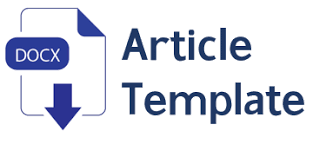Perceptions, Barriers, and Challenges of Healthcare Providers in Adolescent Pregnancy Prevention Services: A Scoping Review
Downloads
Background: Adolescent pregnancy remains a significant global health problem, this is
because related with increased risks to maternal and child health, psychology, as well as
its socioeconomic. Efforts to provided quality adolescent sexual and reproductive health
(ASRH) services as pregnancy prevention still need an understanding from the perspective
of healthcare providers. Objective: This review aimed to explored the perceptions,
barriers and challenges faced healthcare providers in provided ASRH services as an effort
to prevent and reduce cases of adolescent pregnancy. Methods: The procedures began with
a search on Scopus, ScienceDirect, dan EBSCOhost databases studies published between
2020 until 2025 using Arksey and O'Malley's framework and the PRISMA-ScR checklist. Based
on the search results, a total of 11 peer-reviewed studies met stringent inclusion criteria,
focusing perspective of healthcare providers. Results: This review was done of 11 articles
that were screened and analyzed out of 337 articles. The articles come from United States
of America, Uganda, South Africa, Tanzania, Lebanon, Haiti, Zambia, and Kenya, 9 articles
utilizes qualitative designs and 2 articles utilizes cross-sectional designs. Conclusion: This
review providing an overview variations in perceptions, barriers and challenges from
perspective if healthcare providers in various countries on implementation of ASRH services
and indicates need a holistic approach not only to adolescents as service recipients, but
also to healthcare providers as key actors.
Chandra-Mouli, V. et al. (2019) ‘The
Political, Research, Programmatic,
and Social Responses to Adolescent
Sexual and Reproductive Health and
Rights in the 25 Years Since the
International
Conference
Population
and
on
Development’,
Journal of Adolescent Health, 65(6,
Supplement), pp. S16–S40. Available
at:https://doi.org/https://doi.org/
1016/j.jadohealth.2019.09.011.
Chilambe, K. et al. (2023) ‘Experiences of
teachers
and community-based
health
workers in addressing
adolescents’ sexual reproductive
health and rights problems in rural
health systems: a case of the RISE
project in Zambia’, BMC Public
Health,
(1).
Available
https://doi.org/10.1186/s12889
-15199-5.
at:
Corley, A.G. et al. (2022) ‘Exploring and
Monitoring Privacy, Confidentiality,
and Provider Bias in Sexual and
Reproductive
Health
Service
Provision to Young People: A
Narrative Review’, International
Journal of Environmental Research
and Public Health, 19(11). Available
at:
https://doi.org/10.3390/ijerph1911
Erasmus, M.O., Knight, L. and Dutton, J.
(2020)
‘Barriers
to
accessing
maternal health care amongst
pregnant adolescents in South
Africa:
a qualitative study.’,
International journal of public
health,
(4),
Available
pp.
–476.
at:
https://doi.org/10.1007/s00038
-01374-7.
Fahme, S.A., Sieverding, M. and
Abdulrahim, S. (2021) ‘Sexual and
reproductive health of adolescent
Syrian refugee girls in Lebanon: a
qualitative study of healthcare
provider
and
perspectives.’,
educator
Reproductive
health, 18(1), p. 113. Available at:
https://doi.org/10.1186/s12978
-01170-3.
Govender, D., Taylor, M. and Naidoo, S.
(2020) ‘Adolescent pregnancy and
parenting:
Perceptions
of
healthcare providers’, Journal of
Multidisciplinary Healthcare, 13,
pp.
–1628.
Available
at:
https://doi.org/10.2147/JMDH.S25
Guttmacher Institute (2022) Adding It Up:
Investing in Sexual and Reproductive
Health. New York. Available at:
https://www.guttmacher.org/addin
g-it-up.
Hamza, Y. (2021) ‘Experiences of Married,
First-Time Pregnant Adolescents
When Seeking Care in Kano State’,
Walden Dissertations and Doctoral
Studies [Preprint]. Available at:
https://scholarworks.waldenu.edu/
dissertations/10990.
Hlongwa, M., Tlou, B. and Hlongwana, K.
(2021)
‘Healthcare
knowledge
and
providers’
perceptions
regarding the use of modern
contraceptives among adolescent
girls in Umlazi Township, KwaZulu
Natal province, South Africa.’, The
Pan African medical journal, 38, p.
Available
at:
https://doi.org/10.11604/pamj.202
38.124.20771.
Janighorban, M. et al. (2022) ‘Barriers to
vulnerable adolescent girls’ access
to sexual and reproductive health’,
BMC Public Health, 22(1), pp. 1–16.
Available
at:
https://doi.org/10.1186/s12889
-14687-4.
Maheshwari, M. V et al. (2022) ‘Maternal
and
Neonatal
Outcomes
of
Adolescent Pregnancy: A Narrative
Review’, Cureus, 14(6), pp. 1–10.
Available
at:
https://doi.org/10.7759/cureus.25
Malapela, R.G., Mboweni, S.H. and
Risenga, P.R. (2023) ‘Perceptions of
community health workers on
teenage pregnancy in rural Limpopo:
A qualitative study’, African Journal
of Primary Health Care and Family
Medicine, 16(1), pp. 1–9. Available
at:
https://doi.org/10.4102/PHCFM.V1
I1.4296.
Manhica, H. et al. (2021) ‘Promoting
sustainable health and wellbeing for
pregnant adolescents in Uganda – A
qualitative case study among health
workers’, International Journal of
Africa Nursing Sciences, 14(October
.
Available
at:
https://doi.org/10.1016/j.ijans.202
100306.
Mutea, L. et al. (2020) ‘Access to
information and use of adolescent
sexual reproductive health services:
Qualitative exploration of barriers
and facilitators in Kisumu and
Kakamega, Kenya.’, PloS one,
(11), p. e0241985. Available at:
https://doi.org/10.1371/journal.po
ne.0241985.
Mwakawanga, D.L. et al. (2021) ‘Would
you offer contraception to a 14
year-old girl? Perspectives of health
students and professionals in Dar es
Salaam, Tanzania.’, Reproductive
health, 18(1), p. 245. Available at:
https://doi.org/10.1186/s12978
-01294-6.
Ooms, G.I. et al. (2022) ‘Healthcare
workers’ perspectives on access to
sexual and reproductive health
services in the public, private and
private not-for-profit sectors:
insights from Kenya, Tanzania,
Uganda and Zambia’, BMC Health
Services Research, 22(1), pp. 1–11.
Available at:
https://doi.org/10.1186/s12913
-08249-y.
Purnami, C.T., Wicaksono, F.A. and
Permani, F.P. (2023) ‘Upaya
Pencegahan Kehamilan Remaja
Melalui Model Sistem Informasi
Kesehatan Reproduksi di Negara
Maju dan Berkembang : Literatur
Review’, Jurnal Kebijakan
Kesehatan Indonesia, 12(4), p. 184.
Available at:
https://doi.org/10.22146/jkki.8770
Sidamo, N. et al. (2024) ‘Exploring Barriers
to Accessing Adolescents Sexual and
Reproductive Health Services in
South Ethiopia Regional State: A
Phenomenological Study Using
Levesque’s Framework’, Adolescent
Health, Medicine and Therapeutics,
Volume 15(March), pp. 45–61.
Available at:
https://doi.org/10.2147/ahmt.s455
Sieving, R.E. et al. (2020) ‘Understanding
Primary Care Providers’ Perceptions
and Practices in Implementing
Confidential Adolescent Sexual and
Reproductive Health Services’,
Journal of Adolescent Health, 67(4),
pp. 569–575. Available at:
https://doi.org/10.1016/j.jadoheal
th.2020.03.035.
Solo, J. and Festin, M. (2019) ‘Provider
Bias Family Palnning Sevices: A
Review of Its Maeaning and
Manifestations’, Global Health:
Science and Practice, 7(3), pp. 371
Tabaac, A.R. et al. (2022) ‘Healthcare
Providers’ Perspectives on
Pregnancy Experiences among
Sexual and Gender Minority Youth’,
Sexual & Reproductive Healthcare,
pp. 0–27.
UNFPA (2013) ADOLESCENT PREGNANCY : A
Review of the Evidence, UNFPA.
New York.
WHO (2024) ‘Adolescent Pregnancy’,
World Health Organization.
Available at:
room/fact
sheets/detail/adolescent
pregnancy.
Wooten, S. et al. (2024) ‘Barriers to
pregnancy prevention for
adolescents in rural Haiti:
perceptions of healthcare
providers’, BMC Women’s Health,
(1). Available at:
https://doi.org/10.1186/s12905
-03136-6.

This work is licensed under a Creative Commons Attribution-NonCommercial-ShareAlike 4.0 International License.

In order to be accepted and published by Jurnal Promkes: The Indonesian Journal of Health Promotion and Health Education, Author(s) who submit an article should complete all the review process. The copyright of received articles assigned to the Jurnal Promkes: The Indonesian Journal of Health Promotion and Health Education,and Department of Health Promotion and Behavior Science, Universitas Airlangga as publishers of the journal. The intended copyright includes the rights to publish articles in various forms (including reprints).
Jurnal Promkes: The Indonesian Journal of Health Promotion and Health Education's website. Authors are allowed to use their works for any purposes deemed necessary without written permission from Jurnal Promkes: The Indonesian Journal of Health Promotion and Health EducationS and/or Department of Health Promotion and Behavior Science, Universitas Airlangga with an acknowledgement of initial publication in this journal.
The Editorial Team of Jurnal Promkes: The Indonesian Journal of Health Promotion and Health Education and Department of Health Promotion and Behavior Sciences strive to ensure that no errors occur in the articles that have been published, both data errors and statements in the article.
Users of this website will be licensed to use materials from this website following the Creative Commons Attribution-NonCommercial-ShareAlike 4.0 International License. No fees charged. Please use the materials accordingly.
------------------------------------------------------------------------------------------------------------------------------------------------------------------------------------------
Attribution ” You must give appropriate credit, provide a link to the license, and indicate if changes were made. You may do so in any reasonable manner, but not in any way that suggests the licensor endorses you or your use.
NonCommercial ” You may not use the material for commercial purposes.
ShareAlike ” If you remix, transform, or build upon the material, you must distribute your contributions under the same license as the original.


























